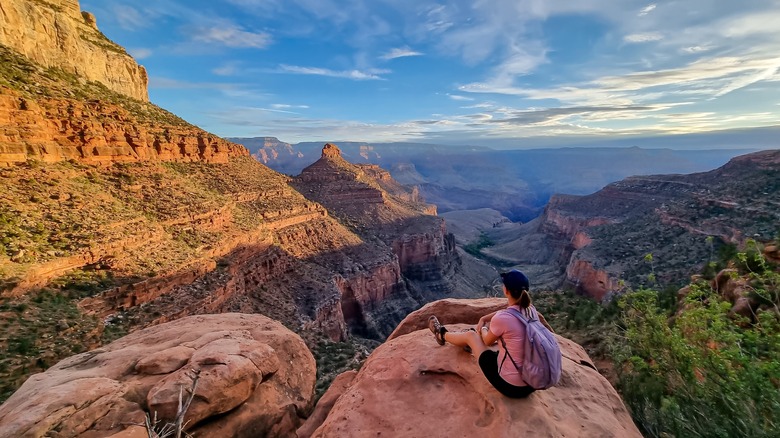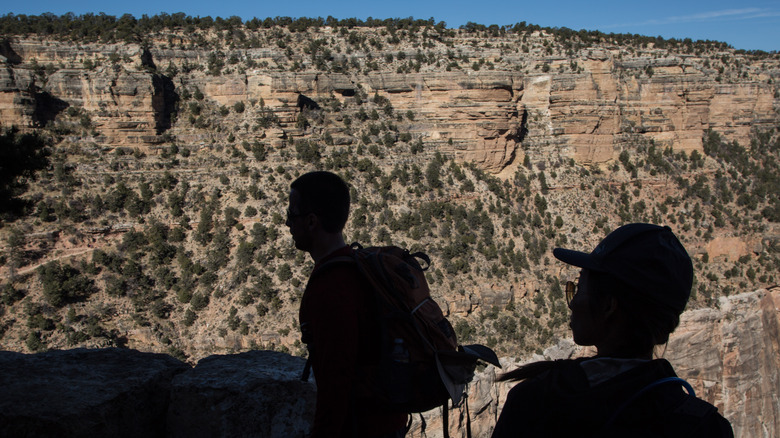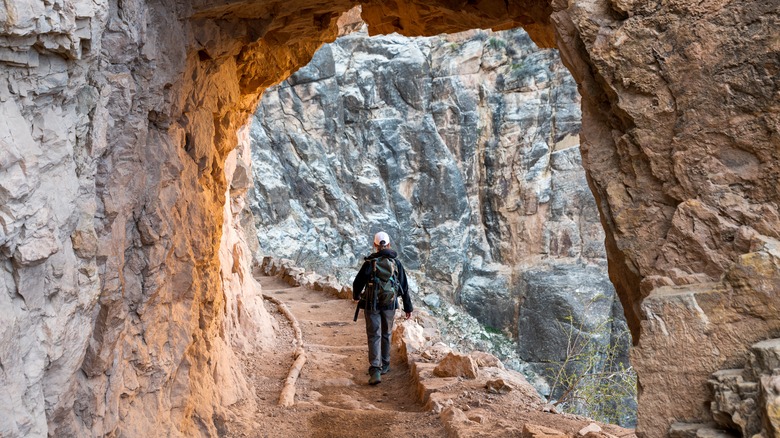This Iconic National Park Hike Is Considered One Of The Most Dangerous In America
The Grand Canyon is one of the most iconic natural landmarks in the world, and arguably, the best place to see it is the Bright Angel Trail. The path takes hikers almost 4,400 feet down and back up again, with sweeping views of the canyon all the way to the rushing Colorado River below. Unsurprisingly, this is a tremendously popular trail, with visitors coming to Arizona's Grand Canyon National Park from all over the world to attempt it. Unfortunately, it can also be extremely dangerous, even deadly.
People often underestimate Bright Angel, though it is one of many U.S. national park trails only experienced hikers should attempt. As signs along the trail warn visitors: "Down is optional. Up is mandatory." This is an out & back trail, meaning you go back up out of the canyon the same way you came in. Unfortunately, the way down on Bright Angel can be misleading because the way back is a lot harder. Enamored with the incredible views and encountering little difficulty traversing the seemingly easy trail, hikers may keep going long after they should turn back. Many don't realize until it's too late just how exhausting the way out of the canyon will be.
Just how dangerous is the Grand Canyon's Bright Angel Trail?
According to NPS, millions of visitors flock to the Grand Canyon, a classic summer road trip destination, annually (far more than its lesser-known but also stunning neighbor, Petrified Forest National Park). Though beloved spots, you must remember that the Grand Canyon and its most popular trail, Bright Angel, have multiple features that could prove deadly. NPS reported 302 search and rescue incidents and 455 hiker assists in 2023 alone. That same year, at least three hikers died attempting the Bright Angel Trail. One of these individuals even came prepared with an emergency device that sent his location to rescuers, but they arrived too late to save him.
Slipping and falling would be deadly high up on Bright Angel Trail, but overheating and overworking yourself present the greatest dangers. Many deaths in Grand Canyon National Park, including places beyond Bright Angel, result from a combination of exhaustion and dehydration. Temperatures in the canyon can soar up to 120°F. At these heat levels, even young, fit, and experienced hikers are at risk if they can't access water and shelter when they need it. "When it's sunny and over 95 degrees in the canyon, our call volume for emergency medical response and rescue goes way up," paramedic and backcountry park ranger Jeff Schwartz explained to The New York Times.
How to stay safe on Bright Angel Trail
"We got about 1/2 mile in and turned around. Wanted to go much further, but the amount of snow and ice ... prevented us logically going on," one hiker recounted on Tripadvisor. "Although we weren't on as long as we wanted to be, the views were breathtaking and stunning! Can't wait to do it again in warmer weather and get further down!"
While this trekker felt disappointed that they did not make it to the bottom of the canyon, they had the right strategy for attempting Bright Angel: if you get tired, the trail looks rough, or you run low on supplies, take a break, rest up, and go back. Since you'll have a harder time returning than going down, you need to remain mindful of how you feel and realistic about whether you have the energy and resources to make it back. It's not worth risking your life for the satisfaction of completing a trail.
If you plan to hike Bright Angel, the National Park Service suggests avoiding the heat of the afternoon sun in the summer and asking park rangers about icy trail conditions during the rest of the year. If you want to attempt Bright Angel as a solo hike, make sure to review the safety tips and take extra precautions. You should also never head out without enough supplies: high-calorie snacks and plenty of water are essential for a safe experience.


